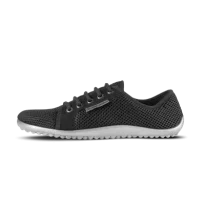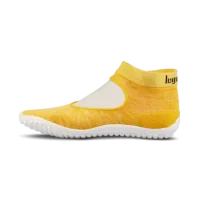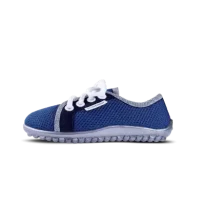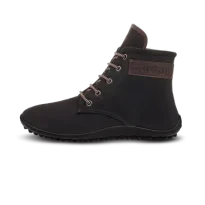Features of barefoot shoes
The special thing about barefoot shoes: The wearer walks in shoes that allow protected barefoot walking , restricts the natural movement as little as possible and at the same time allows the feeling of walking barefoot to be experienced. It's like a barefoot feeling despite the shoes.
Advantages of barefoot shoes over conventional shoes
Conventional shoes such as sneakers, high heels or dress shoes often have a narrow toe box and a thick, stiff sole with a heel. At leguano, we believe that shoes should adapt to our natural feet and not the other way around. That's why we have made it our mission to develop shoes that enable a natural gait and restrict the natural shape of the foot as little as possible.
FOOTROOM
FLEXIBLE SOLE
ZERO SALES
Wide toe box for more foot freedom
In the human foot, the width of the toes is naturally wider than the ball of the foot. However, most shoes are pointed and force the toes into an unnatural position, which leads to deformations such as hallux valgus. To ensure that the toes have enough space in the shoe and can move freely, the employees of the barefoot shoe manufacturer sew additional width into the tip of the shoe, in the so-called toe box . This prevents bruising, blisters and prevents foot deformations. This is because this extended toe box gives the foot plenty of room to expand.
Feather-light for more comfort
Barefoot shoes are lightweight . Most minimal shoes weigh no more than 250 grams . "Normal" street shoes weigh about twice as much. However, the lighter a shoe is, the better it is for the running movement. The heavier the shoes, the more the leverage changes when running. With heavy shoes, the legs swing much further forward than is the case without shoes. This is particularly noticeable when jogging.
Flexible sole for natural freedom of movement
The leguano-typical sole is three-dimensionally flexible and can adapt to every movement of the wearer. It is also thinner than conventional shoe soles. Due to its special structure, sensory stimuli are passed on to our nervous system unfiltered. This means you get as close as possible to the feeling of walking barefoot while still being protected from environmental influences. The upper material is also flexible and light to restrict the foot as little as possible, meaning only as much shoe as necessary.
Zero heel for an upright posture
Barefoot shoes have no heel and no drop. This refers to the difference in height between the heel and the forefoot. This drop leads to an unnatural load on the forefoot: while only a small part of the body weight rests on the forefoot and toes when walking barefoot, heels shift the weight and thus place excessive strain on the forefoot. This permanent strain often leads to a tense posture and has a negative impact on muscles, shins, knees and joints, while minimal shoes with a zero heel protect joints, tendons and back.
All of these properties, especially the "zero drop", mean that the body is in a "zero position". Feet, knees, hips and spine are in a natural and upright position . The body can perform its natural movements and functions unhindered.
If you haven't walked barefoot for a long time, you shouldn't overdo it: it's best to walk barefoot for short periods of time and short distances at first - 10 minutes a day is enough to start with. If you walk too quickly for too long without shoes, you risk damage from overuse. The foot should be allowed to slowly get used to the new strain.

Still questions?
In our FAQs we answer frequently asked questions, for example about sizing, possible uses or shipping and returns.





